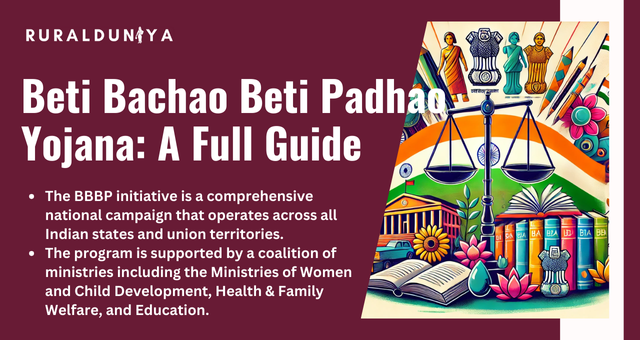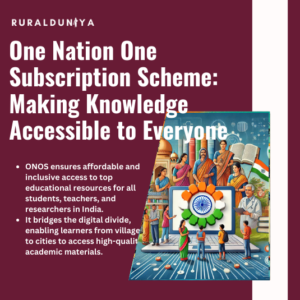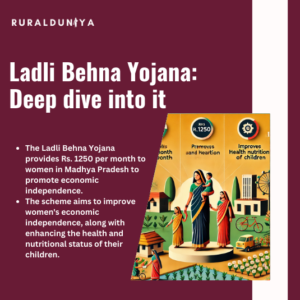The “Beti Bachao Beti Padhao” (BBBP) initiative, launched by the Government of India in January 2015, focuses on addressing the alarming Child Sex Ratio (CSR) and gender bias.
This comprehensive campaign translates to “Save the girl child, educate the girl child,” aiming to eradicate gender-based discrimination and enhance educational opportunities for girls, fostering an environment of equality and empowerment.
Beti Bachao Beti Padhao Yojana: A Full Guide

The Beti Bachao Beti Padhao program is a key governmental initiative aimed at empowering the girl child in India. Triggered by concerning CSR figures from the 2011 Census, the government rolled out BBBP to combat gender imbalances.
It promote a supportive environment for the growth and development of girls and emphasizes education as a fundamental right and seeks to eradicate discriminatory practices against girls. Operating as a national campaign, BBBP spans all Indian states and union territories.
It is supported by a coalition including the Ministries of Women and Child Development, Health & Family Welfare, and Education. This multi-sectoral collaboration ensures the program’s broad reach and effectiveness, addressing various aspects of gender inequality.
Objectives of Beti Bachao Beti Padhao
The objectives of BBBP are:
- Prevent gender-biased sex selective elimination.
- Ensure survival and protection of the girl child.
- Encourage education and participation of the girl child. The initiative employs awareness campaigns, community mobilization, and improved service delivery to achieve these goals.
History of Beti Bachao Beti Padhao
BBBP was launched with an initial investment of Rs. 100 crores to directly address the skewed child sex ratios highlighted by the 2011 census. Initially focused on 100 districts with low CSRs.
The scheme has since expanded significantly, reflecting the government’s commitment to reforming societal norms and ensuring educational and social opportunities for girls.
Benefits of Beti Bachao Beti Padhao

The program has facilitated numerous benefits, including:
- Improved child sex ratios in targeted districts.
- Enhanced educational outcomes for girls.
- Elevated awareness of the potential and rights of the girl child.
- Increased access to essential services like healthcare and education for girls.
Nibandh (Essay)
This essay emphasizes BBBP’s pivotal role in transforming societal attitudes towards the education and empowerment of the girl child in India. It showcases how the program effectively combines educational outreach with social mobilization to mitigate gender biases.
Regional Focus of Beti Bachao Beti Padhao
Rajasthan: The initiative has dramatically reduced child marriages and enhanced girl child literacy, reshaping societal norms through effective educational programs and community mobilization.
Haryana: Known for its historically skewed gender ratios, Haryana has seen improvements in CSR and educational opportunities for girls, thanks to BBBP.
Jammu and Kashmir: The region focuses on integrating BBBP with local educational and social initiatives to increase impact.
Jharkhand: Emphasizes improving access to education for girls, with programs designed to make education accessible and relevant to their empowerment.
Advantages and Disadvantages

Advantages:
- Promotes gender equality.
- Reduces societal discrimination against girls.
- Enhances educational and health outcomes for girls.
Disadvantages:
- Variability in implementation across regions.
- Challenges in maintaining engagement at the grassroots level.
- Insufficient monitoring and evaluation mechanisms in some areas.
Competition and Zero Budget Advertising
The program employs innovative zero-budget advertising strategies, utilizing competitions and community involvement to spread its message effectively and affordably across various demographics.
Features and Tagline of Beti Bachao Beti Padhao
BBBP’s features include a comprehensive approach to creating a supportive environment for the girl child. Its resonant tagline, “Save the girl child, educate the girl child,” encapsulates its mission of empowering girls through education and equality.
Summing it All Up

Beti Bachao Beti Padhao stands as a significant government initiative, deeply impacting India’s social fabric. It demonstrates how structured governmental interventions, combined with community participation and innovative outreach.
It can effectively promote gender equality and education for girls. As the program evolves, ongoing adaptation and enhancement of its strategies are essential for addressing emerging challenges and ensuring continued success in empowering the girl child.
FAQs
What is the main goal of the Beti Bachao Beti Padhao scheme?
The main goal of the scheme is to address the declining Child Sex Ratio in India by preventing gender-biased sex selection and ensuring the survival, protection, and education of the girl child.
How can one apply for the Beti Bachao Beti Padhao scheme?
To apply for the scheme, contact the nearest Women and Child Development office in your district. They will provide guidance and necessary forms based on the specific requirements and interventions in your area.
What are the benefits of the Beti Bachao Beti Padhao scheme?
The benefits of the scheme include improved child sex ratios, increased educational opportunities for girls, and heightened public awareness about the importance of nurturing and educating the girl child.
Which ministries are involved in the Beti Bachao Beti Padhao initiative?
The initiative is a collaborative effort involving multiple ministries, including the Ministry of Women and Child Development, Ministry of Health and Family Welfare, and the Ministry of Education.

Nishank is a social impact enthusiast with a solid foundation in public policy, micro-enterprise, and agribusiness. Growing up in a farmer’s family has given him a profound connection to rural communities, fueling his passion to empower people towards self-reliance. He completed his undergraduate studies at the Delhi University and earned a master’s degree in Rural Management from National Institute of Rural Development & Panchayati Raj in Hyderabad.



